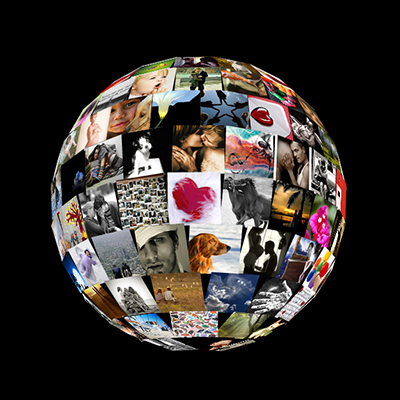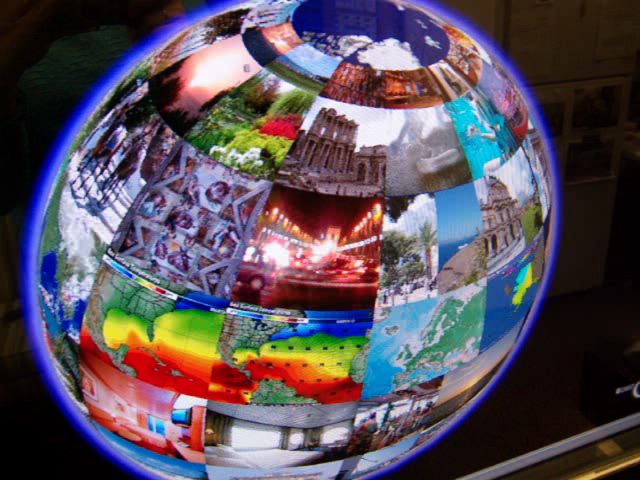

Steven Wood's Tag Galaxy
Via Papervision3D, Richard Banks, and Flowing Data
Tag Galaxy is an application that uses Flickr and Papervision 3D. If you type in a tag, the tag is represented as the sun in the galaxy, and related tags are represented as planets. When you rotate and browse through the galaxy in 3D space, you can view the pictures according to the tag. Steven Wood created Tag Galaxy for his thesis project.
Separated at Birth? Vacation pictures on an interactive photo-globe - April 2007
Vacation pictures on an interactive photo-globe - April 2007 The first day I learned about Microsoft Surface will be etched in my memory forever...
It is not because I'm a 100% Microsoft fan. It is because I'd been thinking about touch-screen interaction since my first encounter with an interactive whiteboard several years ago. At the time, I was involved with group counseling with middle school students, seated around a table.
What would happen if we took the whiteboard put it on a table?
As noted below, the demo projects worked best on a NextWindow Human Touch. Although the large display was only "single-touch", it provided excellent resolution and touch response. Since then, NextWindow has come out with a multi-touch display, which I've had a chance to see. It is not a table, but it has possibilities.
What would happen if we took a NextWindow multi-touch display and mounted it onto an adjustible drafting board? It could be used as a vertical display, a "surface" table, and a drafting board. The best thing is that this could support quite a bit of collaborative work between two or more people, as well as learning, creative-artistic, and gaming activities.
New things are on the horizon. Windows 7, will replace Vista in the future. Bill Gates has pronounced that "every surface will be a computer". Touch screen surfaces are finding homes on tablet PC's, cell phones, and the latest OLPC "$100.00" laptops for children.
I think there will be more possibilities for using touch-screen technology for education in the very near future.
Here is my post about Microsoft's Surface from last year, with some updates:
Microsoft Surface multi touch screen table - I wish I had one for my projects last semester!
Microsoft Research recently unveiled Microsoft Surface: http://microsoft.com/surface. This multi - touch table can be used for a variety of applications, as outlined in the video from CNET and YouTube below:
I'd like to work on applications for use on a touch-table to support students with special needs, especially those who have autism spectrum disorders.
.....Last semester, I worked on prototype applications for use on a touch-screen surface -here is a photo. We used a NextWindow Human Touch large-screen display, which provided great screen resolution and touch-response.

This application was part of a travel-planning prototype developed for a course in Human Computer Interaction. The application was demonstrated on a NextWindow Human Touch large screen display. Would it work on the iPhone?
Update: Examples from some of my other posts:
Below is another demo video-clip of a globe created in GoogleEarth using photo-overlays, with links to video clips that pop up on the screen. You can spin and rotate the globe at any size, and zoom into the pictures. The above photo and the video clip show the application on a NextWindow Human Touch large-screen display.
This application would be great on a touch-table or touch-table set up on a drafting board. Although it was designed for a travel-planning application, it would work well in educational settings in subjects such as geography.
Poetry Picture Share

This was my first attempt at a "poetry picture share" application. It was designed for eventual use on a multi-touch table. It was developed using JavaScript and Ajax. It could be accessed remotely so people in different places can move things around on the screen. The video shows how the application works on a large interactive touch-screen display.
I am planning on adapting this application for use with students with special needs, such as those who have autism or other communication disorders. (Note: I've used it with several students, with success. It still is a work in progress!)
Update:
Link to Papervision 3D: Press the picture to enter a 3-D interactive underwater world...
If you have tried PaperVision 3D or Tag Galaxy on an interactive whiteboard or touch screen display, please leave a comment and share your impressions.

1 comment:
The Microsoft surface computer makes an absolutely spectacular demo movie. Here’s a good one put together by Popular Mechanics.
Post a Comment